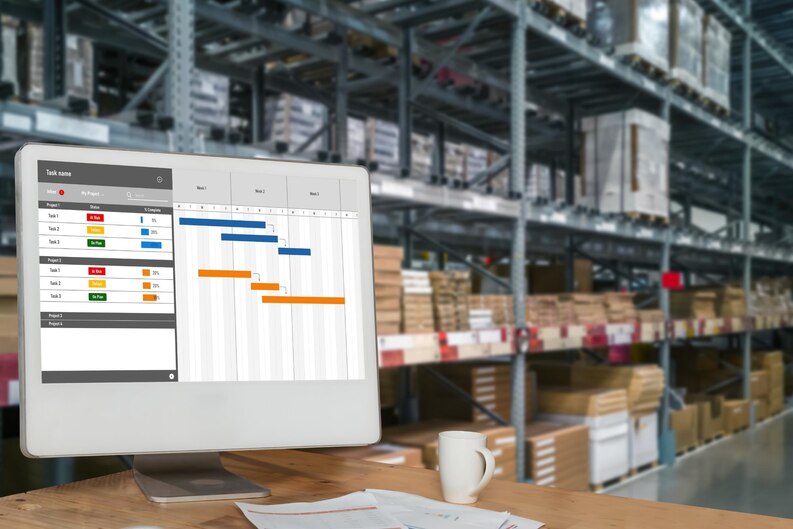With an emphasis on what fulfillment centers do, we will go thoroughly into their roles and internal operations. There is no doubt that fulfillment centers are widely considered the industry’s backbone and help businesses to streamline their order fulfillment and delivery operations smoothly.
What Is a Fulfillment Center?
Fulfillment centers, often referred to as fulfillment companies, play crucial roles for both online and brick-and-mortar retailers by managing a range of labor-intensive responsibilities within the order fulfillment and distribution process.
These companies are often found in big buildings that have shelves, loading areas, and packing spots. They have trained workers and lots of shipping materials. This way, they can get and keep lots of products from different sellers. When someone orders something, they can pack and send it out quickly.
What Do Fulfillment Centers Do?
The ecommerce businesses store their products in fulfillment centers. When customers order online, they take care of the whole packing, shipping and delivering process and make it convenient for customers to get what they have purchased online.
How Do Fulfillment Centers Work?
What does a fulfillment company do? How do they handle the whole process? Well, the functioning of fulfillment centers comprises several essential steps in its operational process:
1. Inventory Arrival
When managing inventory at a fulfillment center, the initial step involves receiving goods. These goods can arrive at the center in two ways: directly from suppliers or through the efforts of the sellers themselves. Whether it’s a bulk shipment of cutting-edge gadgets or individually packaged handcrafted items, this primary arrival sets the stage for subsequent activities within the fulfillment center.
2. Inventory Sorting
Once the inventory arrives, the fulfillment center diligently examines each item with precision. They thoroughly check quantities to guarantee accuracy and meticulously inspect for any indications of damage or discrepancies. Maintaining effective communication with sellers at this stage is crucial in promptly resolving any issues or inconsistencies that may arise during the inventory check-in process.
3. Storage and Optimization
Fulfillment centers prioritize efficient logistics and swift turnover by carefully storing products. Their focus is on maintaining optimal inventory levels to efficiently meet customer demands. To achieve this, regular shipments are ensured and features like climate control are implemented to accommodate the diverse storage requirements of different types of merchandise. The centers strive for seamless operations that cater to customer needs effectively.
4. Order Processing
When it comes to handling customer orders, fulfillment centers ensure a seamless process. Various methods are employed to route customer orders to the fulfillment center, guaranteeing a hassle-free and connected system.
5. Order Fulfillment
This is the stage where the company gets orders right from customers. It’s a process called pick, pack, and ship that ensures each order is processed accurately and promptly.
Here’s how it works:
Product Selection:
The staff meticulously searches the inventory to locate and select the specific products that have been ordered. This step is crucial to guaranteeing the accurate fulfillment of each order.
Packing Orders:
After the products are selected, they are carefully packed, ensuring that they are properly secured to avoid any damage during shipping.
Shipping Parcels:
After carefully packing and labeling the orders, they are then entrusted to reliable shipping carriers. These carriers play a crucial role in ensuring that customers receive their orders promptly and accurately.
6. Handling Returns
Fulfillment centers play a crucial role in managing product returns, providing convenience for sellers and customers alike. When customers want to return items, they can easily send them back to the fulfillment center. At the center, returned products undergo a thorough assessment. Sellers have flexibility in deciding how to handle these returns. They may choose to reintegrate them into their inventory, offer them at discounted clearance prices, or discard them if they cannot be resold. This streamlined returns management process ensures a seamless and hassle-free experience for all involved in the e-commerce cycle.
Starting a Fulfillment Center Business
How to start a fulfillment center entails a series of essential steps to establish your operation.
1. Find a Suitable Space
Start with a space that suits your initial needs, whether it’s a small facility or a shared space with other companies. Ensure that there’s room for expansion to accommodate potential growth.
2. Streamline with Software
Implement efficient operating processes by utilizing software and logistics apps to manage warehouse operations, customer orders, and shipping.
3. Set and Monitor KPIs
Determine KPIs like order lead time and return rate to measure how your business is performing. These metrics should be monitored continuously and remedies should also be put in place in order to sort out any emerging concerns immediately.
Conclusion
Order fulfillment is an integral pillar to success for businesses engaged in online retail or even those operating within traditional retail setups. Understanding their functions and operational aspects is crucial for those companies seeking to enhance their online businesses. Creating a successful fulfillment center business needs careful planning combined with a wise use of modern technology.













